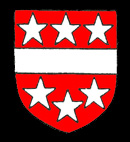The Manor of Oclee cum Clapham alias Clapham Bayeux
Volume III of The Victoria County History for Bedfordshire was published in 1912 and gives an account of the manors of Clapham. The Manor of Ocle-cum-Clapham alias Clapham Bayeux alias Vauxes was, as the name suggest, on the borders of Oakley and Clapham and had land in both. Like the Manor of Clapham Greenacres the overlordship was held by the Honour of Wallingford [Oxfordshire].
The first known tenant of the manor under the Honour is Simon son of Richard de Bayeux in 1276 when William de Bayeux quitclaimed his right of the manor to him. By 1278 the manor comprised four hides and half a virgate, with fifty acres of woodland and rights of common fishery from Oakley church to Oliver’s Ditch, according to the Hundred Roll. In 1306 Simon de Bayeux settled the reversion of the manor on Alexander de Stoppesley and Matilda, his wife, who may have been de Bayeux’s daughter.
The de Stoppesley family held the manor until 1414 when Alexander de Stoppesley quitclaimed it to Sir Gerard Braybrook and others, perhaps as a preliminary to alienating it to Sir William Thirning because in 1428 his widow was lady of the manor. Thirning’s Northamptonshire property ended up with Sir William Vaux of Harrowden, who was attainted for treason in 1464 and this manor was included in the lands forfeited by the traitor and given by Edward IV (1461-1470 and 1471-1483) to Ralph Hastings.
Henry VIII (1509-1547) reversed Vaux’s attainder and Nicholas, 1st Baron Vaux of Harrowden, William’s son who had been an infant when his father was attainted and still a child when he was killed fighting against Edward at the Battle of Tewkesbury in 1471, received the manor back again. William, 3rd Baron Vaux divided the manor, separating the Oakley lands from those in Clapham and sold the Clapham portion to Thomas Rowe in 1564, uniting the Clapham portion of this manor with the Manor of Greenacres.
The Rowe family held the manor until 1592 when Rowe’s successor Thomas Rowe of Trumpington [Cambridgeshire] sold the manor for £3,644 to George Wyatt, Edward Scanden, John Wright and Valentine Saunders, trustees for recusant Arden Waferer to whom Rowe was indebted. Waferer died in 1617 leaving the manor to his wife Elizabeth until his son James reached the age of twenty five. Elizabeth, also a Roman Catholic, refused to attend church and two-thirds of her property was seized by the Crown when she refused to pay the attendant fine. In 1627 James Waferer alienated the manor to Richard Taylor, a serjeant-at-law.
The manor was sequestrated by parliament in 1649 due to the support given to the Royalist cause in the civil wars by Taylor’s eldest son Richard. However, the sequestration was confined to Richard’s share in 1651 and not extended to those of his younger brothers, one of whom, William, was the captured fighting for the king at Chester. Thomas Taylor was lord of the manor in 1655 and left the manor to his wife Ursula for her life. His heir was his daughter Katherine who married William, 2nd Baron Ashburnham and they seem to have succeeded to the manor before the death of Ursula Taylor.

Ashburnham arms
After Lord Ashburnham’s death his son John, 1st Earl of Ashburnham succeeded to the manor which then remained in the family until 1862 when most of the estates were sold to James Howard, Liberal MP for Bedford and son of the founder of the Howard engineering business operating from Britannia Iron and Steel works in Kempston Road, Bedford. By 1912 all manorial rights had lapsed.